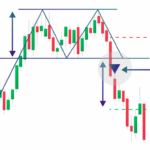Despite the immense potential that crypto markets offer, they also pose challenges associated with extreme volatility, which can be difficult to manage capably. On the other hand, the more predictable price movements in forex markets provide a stabilizing influence on any portfolio.
The Guide on crypto volatility and forex stability compliments the “Keeping a forex strategy with high-growth crypto assets” which helps in mitigating the risk, preserving capital, and sustaining growth in the shifting global financial landscape.
Key Point
| Smart Strategy | Key Point |
|---|---|
| Maintain a Diversified Portfolio | Spread investments across forex majors (USD, EUR, JPY) and strong cryptos (BTC, ETH) to reduce volatility impact. |
| Use Stablecoins as Risk Anchors | Hold safe allocation in stablecoins like USDT, USDC for liquidity and protection during market drops. |
| Follow a Fixed Portfolio Allocation Strategy | Create a set ratio (e.g., 70% forex / 30% crypto) and rebalance periodically to maintain steady risk levels. |
| Apply Stop-Loss and Take-Profit Orders | Automate exits to lock profits and limit losses instead of reacting emotionally to market moves. |
| Hedge Crypto Exposure via Forex Markets | Use hedging tools such as forex CFDs to counter potential losses in highly volatile crypto positions. |
| Focus on Cryptos with Strong Liquidity | Prefer large-cap cryptos with deep market liquidity (BTC, ETH) to avoid slippage and manipulation risks. |
| Use Dollar-Cost Averaging (DCA) | Invest small, consistent amounts over time to neutralize short-term volatility and improve long-term returns. |
| Follow Macro & Regulatory Developments Closely | Monitor central bank policies, interest rates, and crypto regulations for smarter investment timing. |
| Analyze Correlations Between Crypto & Forex | Track how crypto reacts to currency strength (like USD Index) to adjust exposure strategically. |
| Limit Exposure to High-Risk Altcoins | Keep speculative coins as a small percentage to safeguard capital from sudden value collapse. |
1. Maintain a Diversified Portfolio
When facing great market uncertainty, one of the best approaches to take is the multifaceted strategy. As an example, you could incorporate crypto investments with forex trades. This will help you capture the benefits of most stable currencies (USD, EUR, JPY) and still get the potential growth of crypto giants (Bitcoin, Ethereum).

The most potential growth crypto investments will help you stabilize the benefits of currencies. Smart Tips to Balance Crypto Volatility with Forex Stability explain how the best approach is to possess a combination of different assets that will help you stabilize extreme market condition movements on one market.
Maintain a Diversified Portfolio — Key Features
- Risk: Minimizes Over the Entire Portfolio
- Capital Preservation: During Extremely Volatile Periods
- Returns: Balancing Between Crypto and Forex
- Asset Class: Single Over Dependence Avoided
2. Use Stablecoins as Risk Anchors
In times of instability, stablecoins can function as protective anchors, as their values are constant, and can be traded for dollars or other fiat currencies. During periods of high uncertainty, stablecoins can be converted and are low fluctuating and can be stored as liquidity.

Smart Tips to Balance Crypto Volatility with Forex Stability suggests holding some of your resources as stablecoins to mitigate downward risks. In crashing markets, these assets can be liquidated and allow the investor to re-enter at low cost.
During highly unstable periods, crypto traders can safeguard their profits and capital value with stablecoins, and overall the portfolio adapted to the crypto market volatility.
Use Stablecoins as Risk Anchors — Key Features
- Volatility: Low For Secure Allocation Within Crypto
- Gains: Protects During Recession Periods in Crypto
- Liquidity: For Near Instant Transactions
- Price: Stability With Fiat Backing
3. Implement a Fixed Portfolio Allocation Strategy
A fixed portfolio allocation strategy allows you to position yourself properly in both forex and crypto without overexposing yourself to one asset class. A balanced ratio, such as 60% for forex and 40% for crypto, keeps your profile shift, and still allows for growth.

Smart Tips to Balance Crypto Volatility with Forex Stability suggests rebalancing as closely as possible, particularly after extreme moves.
When crypto prices rise, selling enough to rebalance and keep your target ratio allows you to lock in profits; when prices fall, rebalancing by selling crypto allows you to keep your target ratio and reduce emotional trading.
Follow a Fixed Portfolio Allocation Strategy — Key Features
- Risk: Define It Over Time and Maintain It
- Stability: Encourage Periodic Rebalancing
- Discipline: Support Employed For Growth in the Long Term
- Emotion: Avoid Falling Victim To Trading Decisions
4. Implementing Stop-Loss and Take-Profit Orders
Using automated exit strategies like stop-loss and take profit orders will assist in preventing losses from going out of control and capturing profits in a timely manner. These strategies eliminate the emotional component of an investment that can cause panic selling or the risky behavior of holding on to losing positions for extended periods.

Smart Tips to balance Crypto Volatility with Forex Stability advises traders to set risk-reward ratios before entering trades as a means of safeguarding capital.
For instance, a take profit order during a strong up move ensures gains during profit taking periods and a stop loss order placed above critical support levels will reduce exposure during steep market dips.
This positively builds discipline, increasing the pouchs net worth, and enabling the traders to cope during periods of extreme market volatility with certainty.
Apply Stop-Loss and Take-Profit Orders — Key Features
- Protect The Downside: Large Unexpected Losses are Avoided
- Volatility: Risk Management For Highly Volatile Assets
- Secure Cryptos: Protected During Rapid Movements In The Market
- Exit: Automated Exit Points With Defined Time Frames
5. Hedge Crypto Exposure via Forex Markets
Hedging as a risk mitigation strategy relies on advanced forex instruments to cover possible losses from crypto investments. Assuming a fall in Bitcoin while the USD gains in strength permits a long position on the USD pairs to offset a drop in Bitcoin.

Chapter 3 of this book describes in detail the use of forex futures along with CFDs and options to establish protective positions against losses when crypto positions are profitable.
This strategy permits the digital asset holding to hedge the value of the crypto position. Hedging protects the asset in crypto during the period of the highest losses.—
Hedge Crypto Exposure via Forex Markets — Key Features
- Losses: Offset For Unfavorable Positions In Crypto
- Risk: Reduced By Using Forex CFDs, Options, and Futures
- Exposure: Market With Unprotected Pairs While Risk Is Reduced Overall.
- Improves reliability in volatile environments
6. Focus on Cryptos with Strong Liquidity
Liquidity significantly impacts the ability to open and close positions on a cryptocurrency without influencing the price. Cryptos like Bitcoin and Ethereum have high liquidity, tighter spreads, and lower slippage.

In the book Smart Tips to Balance Crypto Volatility with Forex Stability, the author recommends trading high market volume cryptos to minimize the potential for price manipulation.
Altcoins, on the other hand, have low liquidity and can expose the trader to considerable risk and potential loss due to extreme price swings on low volume. Liquid assets provide predictable pricing and a refined risk profile, which protect traders from extreme market movements.
Prioritize Cryptos with High Liquidity — Key Features
- Smooth buying and selling at accurate value
- Minimizes slippage and defense against price manipulation
- Accommodates efficient trading at large volumes
- Reliable market movement and activity tracking is possible
7. Use Dollar-Cost Averaging (DCA)
Instead of worrying about the volatility of the market & the risks that come with price fluctuations, one can use the Dollar-Cost Averaging (DCA) technique, which involves setting aside a predetermined amount of cash for investment at regular & consistent intervals.

It has the power to simple the complicated task of complicated investment position. The info-graphic “Smart Tips to Balance Crypto Volatility with Forex Stability” shows how an investor, willing to avoid emotionally driven decisions from forex market, will prize the method of DCA. Downturn & upturns of the market will help reduce exposure of the asset.
Practice Dollar-Cost Averaging (DCA) — Key Features
- Mitigates market-timing concerns and risks
- Enables the formation of trading positions over time
- Minimizes the risk of emotionally driven decisions
- Reduces the impact of price volatility
8. Regulatory & Macro Developments
Inflation forecast, global policies, and central bank rate decisions steer the direction of the crypto and forex market. Ongoing regulatory changes crypto fixation, crypto exchange restrictions, and crypto taxation will affect the prices and the liquidity of the market.

Traders will move the market to the most liquid instruments available. Geopolitical developments and monetary developments will give the trader an idea of potential price movements.
Tight crypto regulations will make forex more appealing to traders, while lax regulations will make crypto more appealing. Knowledge of these drivers will make strategy stronger and better align with market demand.
Keep a Close Eye on Macro & Regulatory Changes — Key Features
- Predict movement in crypto and forex
- Reduces sudden policy change impacts
- Improves the timing of market entry
- Increases awareness of global risks
9. Analyze Correlations Between Crypto & Forex
Analyzing correlations tells us how one asset reacts to changes in another asset, and in what way. The value of Bitcoin generally weakens when the value of the US Dollar Index rises. Smart Tips to Balance Crypto Volatility with Forex Stability suggests using historical correlation data to strategically determine exposure levels.

A trader measuring the relationship between EUR/USD and BTC, knows when to hold crypto, when to increase forex positions, and when to rebalance. These insights on correlations enable the prediction of new trends, the avoidance of unnecessary risk, and the harmonization of strategies across both markets.
Study Crypto & Forex Correlation — Key Features
- Minimizes the impact of sudden policy changes
- Improves the timing of market entry
- Increases exposure to global risks
10. Limit Exposure to High-Risk Altcoins
Investing in high-risk altcoins can result in high rewards, but extreme volatility and liquidity issues put them in a dangerous category. Allocating 5-10% as a diversion puts breaks on potential losses.

Using Smart Tips to Balance Crypto Volatility with Forex Stability as a guide, picking strong, reliable, and utility-proven projects should be a priority.
Staving off losses with sound projects brings financial stability and averts net losses, which happens when the market, and especially the shaky positions, takes a fall. Risk-managed portfolios tailored to long-term growth should still present the opportunity to gain from exposure.
Scale Down Participation in High-Risk Altcoins — Key Features
- Avoid risky falls and protect capital
- Maintain stability in the portfolio
- Lower exposure to illiquid coins
- Enable risky plays on high-potential coins in a balanced way
Conclusion
To sustain growth while also protecting your capital from unpredictable market swings, balancing the volatility of crypto assets with the stability of forex is the best way to do so. Holding different assets, using stablecoins, risk-balanced allocation of your portfolio, and applying stop-loss, hedging, and DCA in disciplined ways help traders to not secure themselves while also not passing profitable opportunities.
Restricting high-risk altcoins while staying current on macro movements, correlation analysis, and so on improves decision quality and strengthens financial positions. To finish, the goal is not to avoid volatility, but to control it. It becomes far easier to attain long-term success with the appropriate blend of forex stability and crypto innovation.
FAQ
Why should I balance crypto with forex?
Because crypto is highly volatile, while forex pairs — especially major ones like USD/EUR — provide greater stability. This combination protects your capital and smooths long-term returns.
How much of my portfolio should be crypto vs. forex?
Many traders choose a balanced ratio like 60% forex and 40% crypto. The ideal percentage depends on your risk tolerance and experience.
What role do stablecoins play in risk management?
Stablecoins like USDT and USDC act as safe value storage during market downturns, helping you secure profits and reduce exposure to volatility.
How does hedging help control crypto risks?
By using forex derivatives like CFDs or futures, you can offset crypto losses when markets turn bearish, improving portfolio stability.
Why are stop-loss and take-profit orders important?
They automate exit points to prevent emotional decision-making, limit big losses, and ensure profits are captured at the right time.









